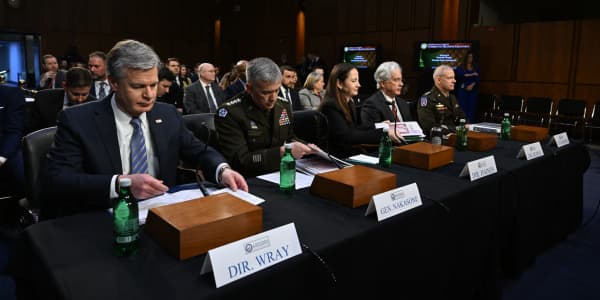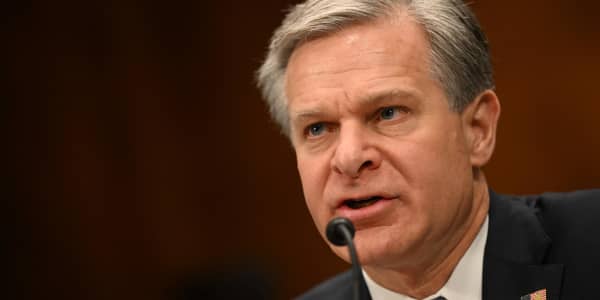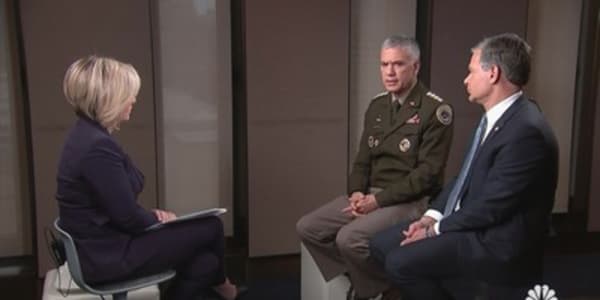Leaders challenged in the C-suite
Being a CEO has never been a stress-free job, but for many corporate leaders, the pressure is greater than ever.
Activist investors, eager to see increasingly greater returns, have little patience for the turnaround "right around the corner" as a stock price craters. Customers, meanwhile, are increasingly loud about their complaints on social media.
"CEOs are more scrutinized if they make mistakes than ever before," said Jeff Wolf, founder of Wolf Management Consultants. How intense is the pressure? Wolf said that it's reached the point where some spend a lot of time second-guessing themselves, but there's a fine line between productive introspection and paranoia.
Here are 11 CEOs who have recently faced significant challenges if not outright attacks on their leadership mettle—and the valuable lessons you can learn from them.
—By Chris Morris, special to CNBC.com
Posted 13 March 2015
Intel's Brian Krzanich
Intel warned Thursday that its first-quarter revenue would disappoint, an outlook that came in even below Wall Street's most pessimistic outlook—$13.2 billion in revenue versus Intel's guide that revenue could be as low as $12.8 billion (plus or minus $330 million).
Intel blamed the new guidance on poor demand for business desktop upgrades, challenging macroeconomic conditions and currency headwinds in Europe. But everyone knows the real challenge: the secular decline of the PC. (Intel noted the "lower than expected inventory levels across the PC supply chain" in an earnings release.)
"It's all handheld," noted Jim Cramer on CNBC's "Squawk on the Street." The money manager claimed that "55 percent of people can't live without their handheld [devices]. Intel is not known for its handheld."
Reports of the PC's "death" have been around for years as the first generation of digital natives computes in a mobile-first world. In one sense, it's remarkable how well Intel stock has performed, given the seismic shift in technology: Intel shares weren't just at a one-year, five-year or decade high at the beginning of 2015, but in late January they were at the highest stock price Intel has reached since the dot-com bubble of 2000. And it seems investors weren't caught as off guard as the headlines this week might suggest: Intel shares were already down double-digits in 2015 before the earnings disappointment.
Leadership lesson: You can get a lot right—and see that reflected in your stock price—but a secular decline in a key product sector will spook market watchers. Expect to address the issue in force, and be prepared to show that your management team is already on top of it.
IBM CEO Virginia Rometty
Rometty recently abandoned the target profit of her predecessor, and the company has reported 10 consecutive quarterly revenue declines. IBM has shed itself of some poorly performing units, but not fast enough for investors. Whether its plan to invest in cloud technology will bear fruit won't be clear for years, which may be too long for anxious investors.
"Part of the problem is having such a huge critical mass," said Kathleen Wailes, senior strategist at Levick. "It's hard to achieve significant growth, so they need to be looking at ways to increase shareholder value the same way an activist shareholder would."
Leadership lesson: You need a long-term vision of your company so investors can understand your product strategy. Old guard companies in fast-changing sectors like technology are particularly challenged. Rometty knows firsthand: IBM shares reached a year-to-date high on Feb. 24—two days before its annual investor day—and have declined since her latest pitch to investors.
Uber CEO Travis Kalanick
Is Uber too hot for its own good? Not when it comes to valuation from investors, now north of $41 billion after a funding round of $1.2 billion in December. But the company is approaching a Facebook-like level of expectations. That gives it a smaller margin of error. And that's ultimately linked to the company's culture being under fire as it continues to battle with regulators in expansion areas.
"There has to be some period of making nice and acknowledging some of the criticism," Wailes said. "Investors are interested in the company, and people love the service, so why stick your finger in people's eyes?"
Uber doesn't have its head in the sand: It hired former Obama White House vet David Plouffe as senior vice president for policy and strategy last year.
Leadership lesson: Ever since the age of the Greeks, hubris has been a dangerous trait. And in an era of start-ups racing to billion-dollar valuations, preparing to act like a "mature" company needs to be part of a hot company's DNA right from the start.
Yahoo CEO Marissa Mayer
Yahoo's stock has more than doubled in the two years since Mayer took over. The downside to that is a lot of the credit goes to the company's one-time stake in Alibaba. Now that it's sold, the questions are mounting about how Mayer plans to revive the core brand and turn around struggling ad sales. And the lack of a solid vision has the wolves circling. Year to date, the stock is down in the double digits percentile.
"She needs to pull off a big move, which could be a sale of the company or a partnership with another big tech company ... some move that would add capability and critical mass to the company," Wailes said.
Leadership lesson: No C-Suite honeymoon lasts forever. Mayer had her glossy photo spread—poolside, no less, and in Vogue—and had the Alibaba valuation to ride for a few years, but now the real challenge begins. In today's world, CEOs have to work quickly to reinvigorate brands to keep them relevant.
GE's Jeff Immelt
Immelt pared back the financial arm of the company that had crippled it during the financial crisis and got GE back to its basics—building things like engines, health-care equipment and power plants—while also keeping an eye on the future and being among the leading companies to invest in the Internet of Things. Meanwhile, Immelt shed underperforming non-core assets, like credit cards and appliances, and poured the proceeds into long-term bets on sectors, including most notably oil and gas services.
The turnaround generated a 60 percent return for investors who stuck with the stock at its financial crisis nadir. But as the old saying goes, "You're only as good as your last day."
After $10 billion in oil and gas acquisitions, GE's "last day" is now being viewed through the prism of an oil sector mired in a profound slump, and shares that after the significant rebound from the worst of the crash, have stalled. Investors want even more financial units sold off, according to a recent report in the Wall Street Journal—from lending specifically. And investors are pressuring Immelt to do whatever it takes to get shares back above $30—the 60 percent return since the financial crisis lags major indexes, and a major catalyst for the stock gains was a one-time event, the return of a dividend paid by GE Capital to the parent company.
Lesson learned: Just when you thought you were out (of a multiyear mess), investors will ask, "What have you done for me lately?", followed by, "What's next?"
Amazon CEO Jeff Bezos
Customers love Amazon, but investors are a bit less enamored. There's an overarching concern that the company—and Bezos, in particular—is sacrificing profit for ventures like the $1 billion acquisition of live-streaming gaming content company Twitch, the failed Fire smartphone and drone delivery.
Bezos historically has been able to deflect criticism for these ventures with a Steve Jobs-like effortlessness, but this time things seem to be different. Activists could be looking for a change, but the stock has rebounded hugely from last year's dive in the first quarter, up 30 percent this year.
Leadership lesson: You need to listen to what Wall Street is saying, but you don't need to be rash. Control your growth; you don't have to be everything to everybody. Last year it seemed that Bezos' forestalling profits for aggressive spending and growth into new markets had finally tested the patience of investors. Yet now Amazon shares sit back near an all-time high after fourth quarter revenue of $29.3 billion and a "surprise" profit of 45 cents per share.
Yelp CEO Jeremy Stoppelman
Even as the company recently posted its first annual profit, its stock was tumbling. Competitors are gaining ground, and complaints to the Federal Trade Commission about the company have increased as the number of Yelp active users has stopped growing.
It's ramping up marketing and last year signed a deal to integrate its reviews into Yahoo's local search results, but investors are fearful the days of high revenue growth are at an end. Late last year a group of shareholders filed a class-action suit against the company, claiming Stoppelman and other executives lied about the company's business practices to inflate the stock price.
Leadership lesson: "Start-ups often get highly valued, and expectations are set too high," Wailes said. "Every CEO has a ticking clock if results are below expectations."
Coca-Cola CEO Muhtar Kent
Warren Buffett continues to sing the praises of living on little more than a half-dozen Cokes a day, but fewer Americans are able to put a smile on their face when it comes to the "benefits" of sugary drink's, or Coca-Cola's stock market prospects.
Net revenues at Coca-Cola were down 2 percent year-over-year through the first three quarters, and the beverage giant has already warned investors it would miss its profit targets for the full year. The company's return for investors, meanwhile, has been well below the S&P 500 average for the past five years as consumers become more health-conscious.
It has launched new ventures, including a premium-priced milk product and buying into the energy drink market with a 16.7 percent stake in Monster Beverage. Now Kent has vowed to expand its cost-cutting program, hoping to save $3 billion per year by 2019. Also on deck are plans to sell its lower-margin bottling operations. Despite better-than-expected earnings last quarter, analysts continue to view 2015 as a turnaround year, where Kent's performance will be closely watched.
Leadership lesson: Sometimes there is no magic formula. Management of old brands need to innovate and acquire but also restructure.
GM CEO Mary Barra
Barra's first year at GM was spent in the hot seat amid several major recalls. That could either weigh her down in 2015 or give her a springboard to emerge as a strong leader with the ability to turn things around quickly. So far, things seem to be going well—shares are up this year after a flat 2014—and a recent demand from activist investors seems to have been satisfied.
In February, Harry Wilson, a former Goldman Sachs banker and member of President Obama's auto bailout team, nominated himself for GM's board as part of a plan to push the automaker to spend more cash on share buybacks. Wilson had the backing of big-name hedge fund managers, including David Tepper of Appaloosa Management. GM announced on March 9 it will buy back $5 billion in shares, and Wilson agreed to drop his board bid.
"[She] needs to rebuild customer trust and confidence after the highly publicized 30-million-car recall and many deaths that resulted from faulty parts," Wailes said. "At the same time, she is improving profits and expanding overseas. The strategy appears to be working."
Lesson learned: As the public face for the company, CEOs need to be prepared for any public relations nightmare that can go viral and be equipped with crisis-management skills that can address operational issues—even in transnational organizations.
Sony CEO Kazuo Hirai
The problems at Sony Entertainment are hardly a secret. Last year's hack, attributed to North Korea, was in response to the release of The Interview and was embarrassing for Sony Entertainment chairman and CEO Michael Lynton and former co-chairperson Amy Pascal, who recently stepped down.
But the issues for Sony are much broader and deeper at the level of the parent company.
Hirai has all of Sony's other problems looming over him. For the first time since 1958, the company has canceled its dividend, and its smartphone division (which he vowed would become the industry's third largest) isn't taking off as hoped. It also is ramping up a web TV service. Operating profits are on the rise, though, and Hirai announced plans last week to split off the company's audio and video unit into separate businesses.
Leadership lesson: When all else fails, rein in your ambitions—even if it means admitting defeat on certain goals. In the end it is all about honesty and integrity. Investors will reward companies willing to hit the reset button: Sony shares are up 35 percent this year and 60 percent in the past year. Though waiting too long is a huge mistake: Sony shares are down near-20 percent over the past five years.
Twitter CEO Dick Costolo
Twitter's one of the top social media sites, but its pace of growth slipped post-IPO, raising concerns about its long-term future. Additionally, the company saw a rash of departures, including Michael Sippey, vice president of product, creative director Doug Bowman, COO Ali Rowghani and VP of engineering Jeremy Gordon, raising questions about its stability and whether CEO Dick Costolo can assemble and retain a team to chart a course for the company's future.
At the same time, the company's failure to address the issue of online harassment of its users has struck a wrong chord, especially as Costolo himself has admitted that the issue is alienating core users and the company has historically sat on its hands while this happened.
The tide seems to have turned in 2015, though. Twitter reached a deal with Google to increase tweet presence in search results and reported quarterly earnings and revenue that beat analysts' expectations, with revenue nearly doubling to $479 million from $243 million a year ago.
Lesson learned: Recruiting, retaining and managing a team of Grade A Players is key to a company's future. Rapid shifts in management is a red flag for investors looking for stability and strategic direction.





